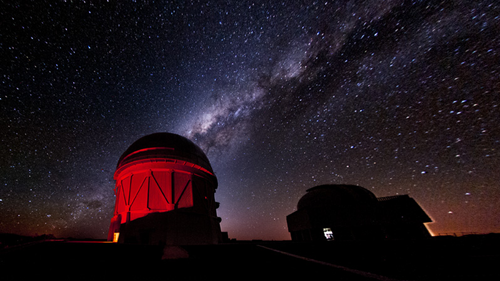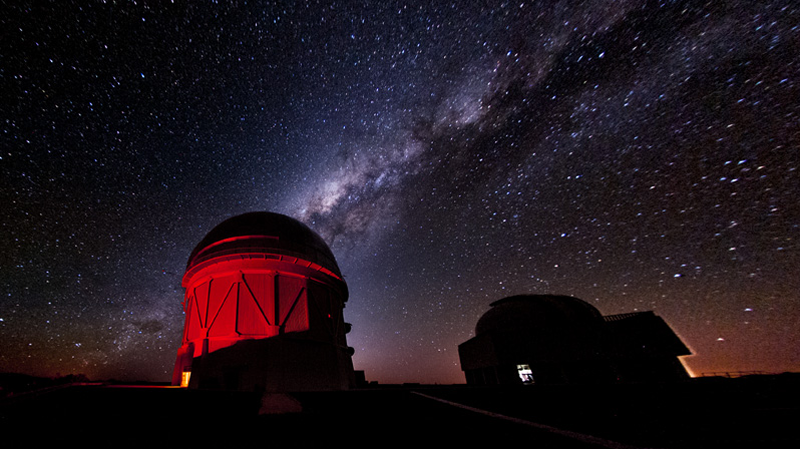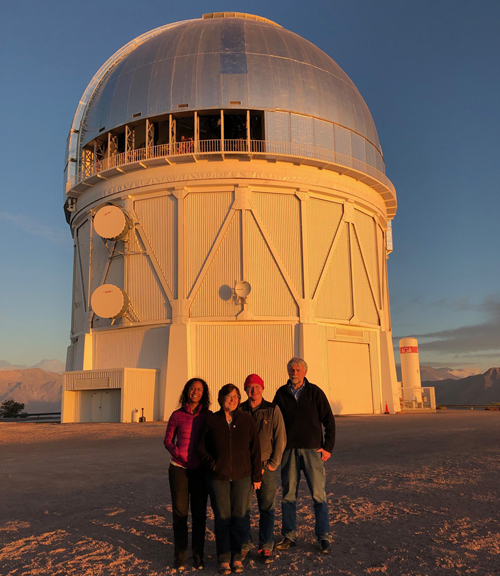Signing Off from Southern Sky Post
On January 9, a handful of researchers with the Dark Energy Survey (DES)—one of the most ambitious attempts to probe the dynamics of the Universe’s expansion—headed to the control room of Chile’s Blanco Telescope. For one last time, they opened the white telescope’s dome. From their perch overlooking the red Andean Mountains, they set up for a night of observing the southern sky.
The researchers were live-streaming their preparations for this final observation to attendees of the winter meeting of the American Astronomical Society (AAS) in Seattle, and the mood was light as the DES researchers shared memories of lasting relationships, of discoveries of distant supernovae, and of the furry hares that frolicked around the telescope. But there was also a sense of anticipation. The DES Collaboration has analyzed less than a fifth of its 100 terabytes of data, and there is good reason to hope that further analysis will lead to a better understanding of dark energy—the mysterious force that causes the accelerating expansion of the Universe.
Operational since 2013, DES uses a wide-view, 520-megapixel camera (DECam) that is sensitive to visible and near-infrared light. The survey focuses on four observables. One is the light of type Ia supernovae, which serve as “standard candles” for inferring the expansion rate of the Universe. Another is gravitational lensing—the bending of light from distant galaxies by matter along the line of sight—which DES uses to map dark matter across the Universe. The two other observables are galaxy clusters, whose cosmic abundance depends on the mix of matter and dark energy, and baryon acoustic oscillations, density fluctuations related to the expansion history of the Universe. To characterize these four observables, DES has collected information on millions of galaxies that are billions of light years away from Earth. With just a preliminary data analysis completed, the collaboration has shown that, when testing cosmology, it can reach the same level of precision as observations of the cosmic microwave background (CMB), the cosmological probe par excellence (see Viewpoint: Weak Lensing Becomes a High-Precision Survey Science).
At the AAS meeting, DES researchers explained what they have learned so far. No big surprises yet, admits DES director Richard Kron of the University of Chicago—the measurements to date are all in line with the current standard model of cosmology, known as CDM. But the survey’s results are much more than a mere confirmation of what we already know from the CMB, explains Kron. CMB observations probe a relatively young Universe (380,000 years after the big bang), whereas DES observes objects formed billions of years later. “The agreement between DES and CMB shows that CDM provides an accurate description of the Universe’s evolution across an incredible span of cosmic time,” says Kron.
As its name suggests, the main target of DES is dark energy. In November 2018, DES reported constraints on cosmological parameters—such as the Hubble constant, the mass density, and the dark energy equation of state—derived from measurements of 207 supernovae that DES had detected in its first three years. “When the analysis is complete, we expect that 3000 supernovae will be usable for dark energy tests—the largest catalog ever used for cosmology,” says DES researcher Chris D’Andrea of the University of Pennsylvania. With this larger sample, he expects to at least double the precision of these cosmological constraints.
Of course, directing a supersensitive camera at a patch of sky for several years was bound to kick up some surprises, not necessarily related to dark energy. In 2016, DES spotted a supernova from 10.5 billion light-years away, the most distant one ever detected. When gravitational waves were observed from a neutron-star merger in 2017, DES was one of the first telescopes to record the merger's visible counterpart. Closer to home, the survey discovered several dwarf galaxies swarming around the Milky Way, suggesting that there may be many more of these galactic neighbors than previously thought. And the collaboration identified streams of stars that were formerly clusters before being tidally disrupted by the Milky Way—an observation that can help constrain the local dark matter distribution. Some of these streams were named by local students after aquatic words from the native Quechua and Aymara cultures.
The legacy of DES now depends on what will be gleaned from the completed survey that spans one eighth of the sky. When the full data are analyzed, DES will put our cosmological models to the most stringent test ever conducted. This may be our best bet, Kron says, at finding cracks in the plain “vanilla” CDM model, which could open the door to new physics: modified gravity, a nonflat Universe, new neutrino species, or a dark energy density that changes in time. Stay tuned for DES news around summer 2019, when the collaboration is expected to release a more complete analysis of its first three years of data.
–Matteo Rini
Matteo Rini is the Deputy Editor of Physics.







